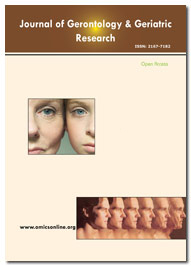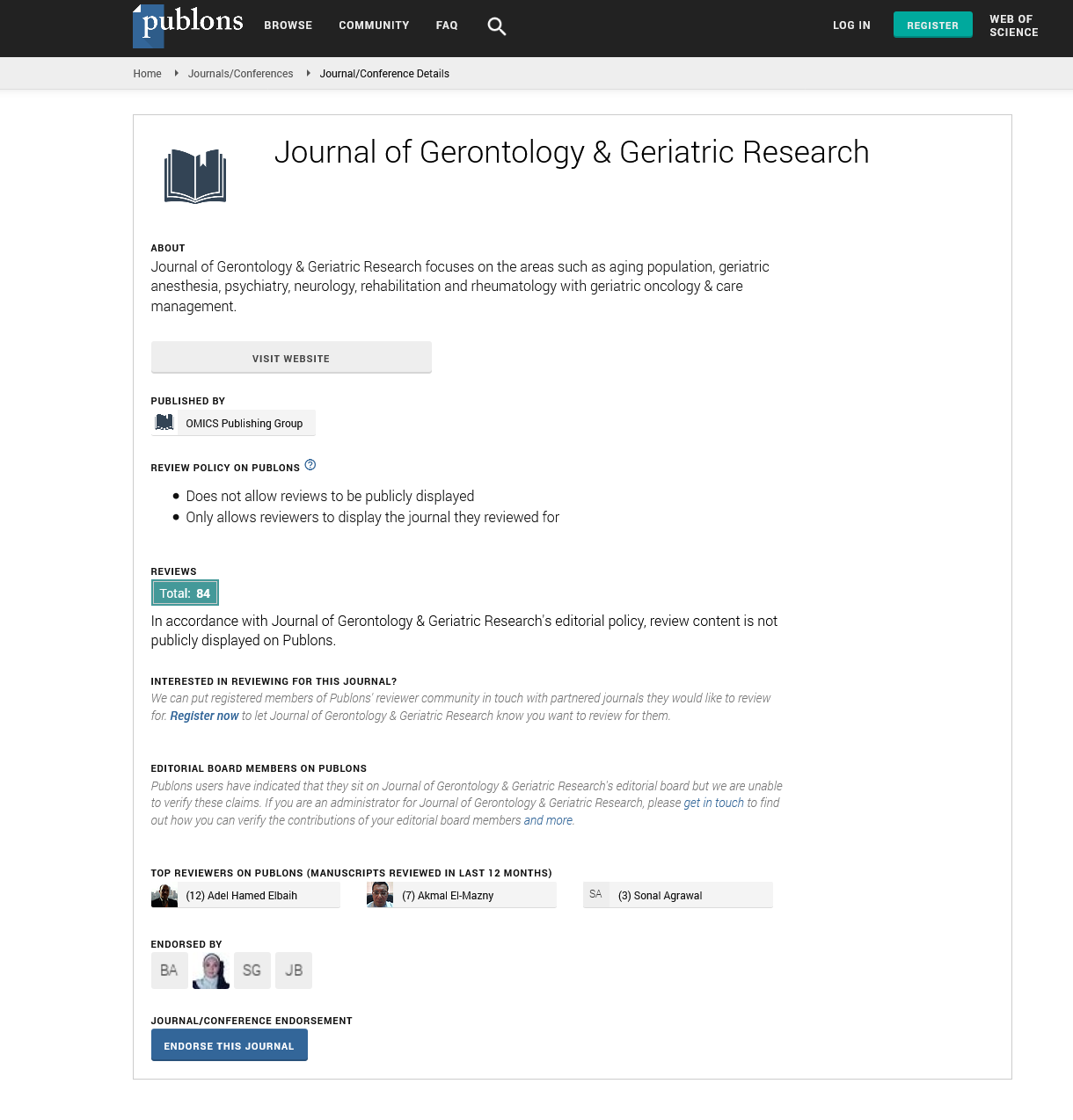Indexed In
- Open J Gate
- Genamics JournalSeek
- SafetyLit
- RefSeek
- Hamdard University
- EBSCO A-Z
- OCLC- WorldCat
- Publons
- Geneva Foundation for Medical Education and Research
- Euro Pub
- Google Scholar
Useful Links
Share This Page
Journal Flyer

Open Access Journals
- Agri and Aquaculture
- Biochemistry
- Bioinformatics & Systems Biology
- Business & Management
- Chemistry
- Clinical Sciences
- Engineering
- Food & Nutrition
- General Science
- Genetics & Molecular Biology
- Immunology & Microbiology
- Medical Sciences
- Neuroscience & Psychology
- Nursing & Health Care
- Pharmaceutical Sciences
Opinion - (2024) Volume 13, Issue 5
The Influence of Physical Activity on Aging: Mechanisms and Recommendations for Geriatric Health
Petro D. Valska*Received: 02-Oct-2024, Manuscript No. jggr-24- 27669; Editor assigned: 04-Oct-2024, Pre QC No. P-27669; Reviewed: 17-Oct-2024, QC No. Q-27669; Revised: 23-Oct-2024, Manuscript No. R-27669; Published: 30-Oct-2024, DOI: 10.35248/2167-7182.2024.13.759
Introduction
Aging is a natural, inevitable biological process marked by the gradual decline of physiological functions. With the growing number of elderly individuals worldwide, understanding the mechanisms that drive aging and finding effective strategies to slow it down has become a primary focus in scientific research. Physical activity is one of the most powerful interventions to combat the effects of aging and promote a healthier, longer life. Engaging in regular exercise has been shown to influence a variety of biological pathways responsible for aging, from cellular and molecular changes to the functioning of organs and systems [1]. This article delves into the relationship between physical activity and the aging process, focusing on how exercise can alter aging mechanisms at different biological levels. It also offers practical recommendations for incorporating physical activity into the lives of older adults to improve both quality of life and longevity. By exploring the scientific evidence and benefits of physical activity, this article aims to highlight how aging can be modulated by lifestyle choices and how exercise can be utilized as a primary tool for promoting geriatric health.
Description
Aging, though a universal phenomenon, is driven by complex biological mechanisms that impact individuals at the cellular, molecular, and systemic levels. One of the key features of aging is the accumulation of cellular damage over time, which results in the decline of tissue and organ function. Cellular senescence, where cells stop dividing and secrete inflammatory molecules, is one of the fundamental processes linked to aging. Additionally oxidative stress—the imbalance between the production of reactive oxygen species and the body’s ability to neutralize them and damages critical cellular components like DNA, proteins, and lipids. This, in turn, accelerates the aging process and contributes to chronic diseases such as cardiovascular disease, diabetes, and neurodegenerative disorders. Another key factor in aging is mitochondrial dysfunction, which leads to reduced energy production and increased vulnerability to metabolic disorders [2]. Inflammation, or "inflammaging," is also a hallmark of aging, contributing to chronic diseases such as arthritis, heart disease, and cognitive decline. Furthermore, as cells divide throughout life, the telomeres at the ends of chromosomes shorten, limiting the number of times cells can replicate and contributing to cellular aging.
Physical activity has been shown to influence all these biological pathways, offering significant benefits in slowing the aging process and mitigating the effects of age-related diseases. Regular exercise has been found to reduce cellular senescence by promoting the removal of damaged cells and stimulating tissue regeneration. It also enhances the body’s antioxidant defense systems, which helps reduce oxidative stress and protect cells from damage. Exercise boosts mitochondrial function by stimulating mitochondrial biogenesis, which increases energy production and improves muscle strength, metabolism, and overall physical function. Furthermore, regular physical activity reduces systemic inflammation, helping to counteract the chronic low-grade inflammation associated with aging. Interestingly, research suggests that physical activity may even help preserve telomere length, potentially delaying the aging process at the genetic level. Exercise also offers substantial benefits for cardiovascular health, improving blood circulation, lowering blood pressure, enhancing cholesterol levels, and improving insulin sensitivity. These improvements reduce the risk of age-related diseases such as heart disease, stroke, and type-2 diabetes [3].
For older adults, incorporating physical activity into daily routines is essential to maintaining health and independence. Recommendations for exercise in the geriatric population should be tailored to individual needs, considering physical abilities, chronic health conditions, and other personal factors. Aerobic activities such as walking, swimming, cycling, and dancing are ideal for improving cardiovascular fitness and endurance. The American Heart Association recommends that older adults engage in at least 150 minutes of moderate-intensity aerobic activity per week, or 75 minutes of vigorous-intensity activity. Strength training exercises are also crucial, as they help to preserve muscle mass, bone density, and joint health, thus reducing the risk of frailty and osteoporosis. Strength training should ideally be performed two to three times per week using weights or resistance bands. Flexibility and balance exercises, such as yoga or tai chi, are also important for preventing falls, improving mobility, and maintaining joint function. Functional training, which mimics everyday movements, helps older adults perform daily tasks like lifting groceries or getting out of a chair without difficulty. A combination of these exercise types is most effective in addressing the multifaceted needs of older adults [4].
Despite the well-documented benefits of physical activity, many older adults face significant barriers to exercise. Physical limitations due to chronic conditions like arthritis, cardiovascular disease, and osteoporosis can make exercise challenging. A fear of injury or falling also prevents many seniors from participating in physical activity, leading to a sedentary lifestyle. Additionally, lack of motivation, either due to physical discomfort or a perceived lack of immediate benefit, can discourage older adults from exercising [5]. Other barriers include limited access to safe exercise spaces, financial constraints, and social isolation, particularly among those living in rural areas or low-income communities. Overcoming these barriers requires education, accessible exercise programs, and supportive environments that encourage older adults to stay active. Community programs, accessible gyms, and online resources can help provide the necessary tools and motivation to ensure that seniors remain engaged in physical activity.
Conclusion
In conclusion, physical activity is an indispensable tool in combating the negative effects of aging. By influencing biological pathways such as oxidative stress, inflammation, mitochondrial function, and cellular senescence, exercise offers a broad range of benefits that help to slow the aging process and prevent age-related diseases. The evidence strongly supports that regular physical activity improves cardiovascular health, increases strength, enhances mobility, and boosts mental well-being. For older adults, adopting a routine that includes aerobic exercise, strength training, flexibility, and balance exercises is essential for maintaining independence and reducing the risk of chronic conditions. However, barriers such as physical limitations, fear of injury, lack of motivation, and limited resources must be addressed to ensure that all older adults have access to the benefits of physical activity. Healthcare providers, caregivers, and policymakers must prioritize exercise as part of a comprehensive approach to geriatric health, creating supportive environments and offering tailored interventions that promote active lifestyles for older adults. As the global population continues to age, integrating physical activity into the daily routines of older individuals will be key to promoting healthy aging, improving quality of life, and enhancing longevity, ultimately reducing the burden of age-related diseases on healthcare systems and societies worldwide.
Acknowledgement
None.
Conflict of Interest
None.
References
- Woo J, Leung J, Morley JE. Defining sarcopenia in terms of incident adverse outcomes. J Am Med Direct Assoc. 2015;16:247-252.
- Xiang T, Fu P, Zhou L. Sarcopenia and osteosarcopenia among patients undergoing hemodialysis. Front Endocrinol. 2023;14:1181139.
- Wada S, Tohara H, Iida T, Inoue M, Sato M, Ueda K. Jaw-opening exercise for insufficient opening of upper esophageal sphincter. Arch Physical Med Rehab. 2012;93:1995-1999.
- Al-Surimi K, Al-Harbi I, El-Metwally A, Badri M. Quality of life among home healthcare patients in Saudi Arabia: Household-based survey. Health Qual Life Outcomes. 2019;17:1-9.
- Alhmoud E, Khalifa S, Bahi AA. Prevalence and predictors of potentially inappropriate medications among home care elderly patients in Qatar. Int J Clin Pharm. 2015;37:815-81.
Google Scholar, Crossref, Indexed at
Google Scholar, Crossref, Indexed at
Google Scholar, Crossref, Indexed at
Google Scholar, Crossref, Indexed at
Citation: Valska PD (2024). The Influence of Physical Activity on Aging: Mechanisms and Recommendations for Geriatric Health. J Gerontol Geriatr Res. 13: 759.
Copyright: © 2024 Valska PD. This is an open-access article distributed under the terms of the Creative Commons Attribution License, which permits unrestricted use, distribution, and reproduction in any medium, provided the original author and source are credited.

